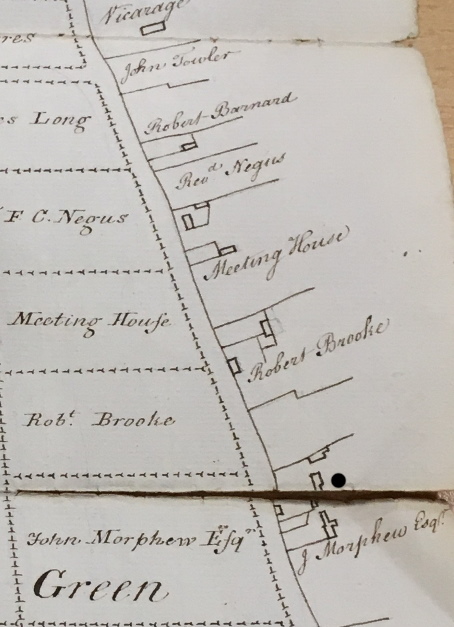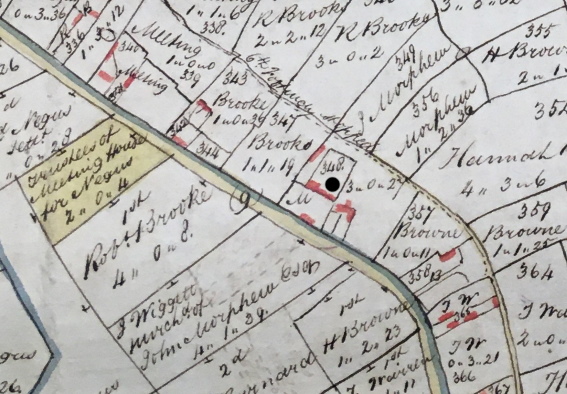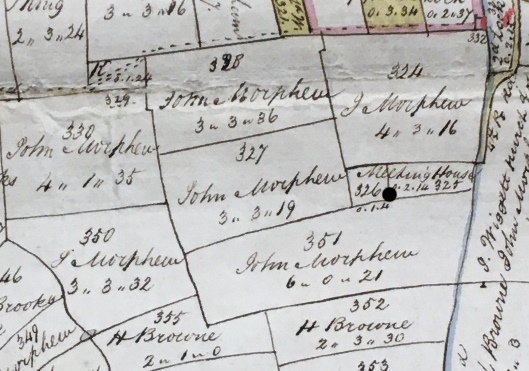Appearing in the edition of the Eastern Daily Press of the 7th September, 1948, was the notice of a forthcoming Auction of a ‘very desirable small farm’ in Great Ellingham.
‘The Cemetery Farm’ was said to comprise of a comfortable farmhouse which had two sitting rooms and five bedrooms. It also had a substantial range of farm premises, as well as 55 acres and 2 roods of arable and pasture land.
At the same Auction, a ‘valuable block of cottage property’ (all let to tenants), adjoining the farm and producing a gross rental of £18 12s, was also being sold.
Why was it called Cemetery Farm and where was it?
The Baptists’ Cemetery (or Burying Ground) lies across fields to the east of Cemetery Farm. The last burials in the cemetery were around 1954. I am told that the hearse would approach the burial ground from the direction of the Queen’s Head Public House, but it would exit via a track adjacent to Cemetery Farm. This is probably why the farm became known as ‘Cemetery Farm’.
Save for the larger farms (for example, Great Ellingham Hall, Bury Hall, Portwood Farm), the farms in Great Ellingham were rarely named in the various nineteenth century trade directories. This makes it difficult to establish who owned or lived at a particular farm.
The census of 1911 reveals the names of only 13 of some 35 farms in Great Ellingham.

Extract from 18th Century Map. Town Green, Hyrne and Broad Commons in Great Ellingham held at Norfolk Record Office.
Cat. Ref. MC2213/113, 941X7. With kind permission of NRO.
Towards the end of the eighteenth century, the property (later known as Cemetery Farm) was owned by John Morphew Esq. The black dot on the above extract from an 18th century map of Great Ellingham shows the position of John Morphew’s house in Long Street.

Extract from 1802 Map of Great Ellingham. Original held at Norfolk Record Office. Russell James Colman Plans.
Cat. Ref. C/Ca 1/84. With kind permission of NRO
The numbering used on a later map of 1802 concurs with the numbering used in a Particulars & Valuation of Great Ellingham c.1800. The above extract of the 1802 map also shows the location of John Morphew’s house in Long Street (numbered 348). Again, I have indentified the property by a black dot.
However, a Schedule included in the Particulars & Valuation c.1800 confirms that at that time, John Wiggett owned the land and premises which was formerly owned by John Morphew. John Wiggett leased the land and premises to John Thurston (who had been a tenant of John Morphew Esq.) This comprised:
- 324. Burying Ground Piece measuring 4 acres 3 rood 16 perches (4a 3r 16p)
- 327. Stony Close 3a 3r 19p
- 328. Dovehouse Piece 3a 3r 36p
- 330. Further new Broken Up Piece 4a 1r 25p
- 348. House, Outbuildings, Barn, Stables, Yard and Garden 0a 2r 20p
- 349. Homestall 3a 0r 27p
- 350. New Broke Up Piece 3a 3r 32p
- 351. Funstones 6a 0r 21p
- 356. Two Acres 1a 2r 50p
- Allotment upon Town Green 4a 1r 39p
- Allotment upon Burying Ground Common 4a 3r 21p
John Wiggett also owned another property (later known as White House Farm), which was also in Long Street, and not far from this particular property.
John Morphew’s Claim under the Inclosures Act
Amongst the claims to the Commissioners in relation to the Great Ellingham Inclosures c.1799 is the claim by John Morphew Esq :
One messuage and 45 acres of land occupied by John Thurston of which 2a 0r 20p are copyhold of Buckenham Castle Outsoken and 2a 2r copyhold of Buckenham Lathes Outsoken.
In addition, John Morphew (along with other landowners) claimed various rights over the commons and waste lands in Great Ellingham.
The farmhouse which was once Cemetery Farm is still standing today. I have no evidence as to when the farmhouse was built. However, given that in the last few years when the property was offered for sale it was referred to as ‘an old farmhouse’, it may well be the same building which was once owned by John Morphew Esq.
Was the Baptist Burying Ground formerly land belonging to John Morphew?
The Baptists’ Burying Ground may have been part of the land once owned by John Morphew Esq. In the informative booklet ‘A Little History of Great Ellingham‘, the authors say it was long-established thinking that the owner of the land offered it to the Baptists’ Trustees “on the prediction and in the hope that they would reject it”. In the event, the offer was not rejected.

Extract from 1802 Map of Great Ellingham. Original held at Norfolk Record Office. Russell James Colman Plans. Cat. Ref. C/Ca 1/84. With kind permission of NRO
The further extract from the 1802 Map of Great Ellingham shows the position of the Baptists’ Burying Ground (which I have shown by a black dot). This land is surrounded by land which was then owned by John Morphew. Given that the Burying Ground was certainly in use towards the end of the eighteenth century, it may have been John Morphew Esq. (or one of his predecessors) that gave (or sold) the land to the Trustees of the Baptist Church.
Earlier Owners of Cemetery Farm before John Morphew Esq.
A paper trail of historical property documents can evidence a chain of ownership of a property. Surviving indentures and conveyances in relation to freehold land, and manorial records relating to copyhold land, can also provide us with the names of tenants in addition to the legal owners.
What is helpful in the case of this particular property is that some of the land owned by John Morphew (and then by John Wiggett) was copyhold. Accordingly, any change of ownership (whether by way of a bargain and sale, or by inheritance) would also be dealt with by the particular Manor Court.
A look at the Manor Court Books for Buckenham Castle Outsoken and Buckenham Lathes Outsoken tell us that at a General Court Baron held on the 26th November, 1801, John Wiggett was ‘admitted’ the copyhold tenant of certain pieces of land of the two Manors on the ‘surrender’ of John Morphew Esq. of the City of Norwich. The date is significant in that the information used to create the 1802 map of Great Ellingham was slightly outdated in that it states John Morphew as owner of this property. However, the Particulars & Valuation c.1800 lists the owner as John Wiggett. Morphew and Wiggett may well have ‘sealed their deal’ well before the Manor Court recorded the transaction.
We can be certain that John Morphew Esquire of the City of Norwich owned Cemetery Farm with the associated buildings during the late eighteenth century. For clarity, I refer to John Morphew’s house as Cemetery Farm even though it may have been much later that it was given the name. I do not know whether John Morphew actually lived in the property.
If we can assume that the owners of the parcels of land which were copyhold of the Manors of Buckenham Castle and Buckenham Lathes (and referred to in John Morphew’s claim under the Great Ellingham Inclosures c.1799) also owned the freehold messuage (Cemetery Farm) and the other parcels of land, it is possible to identify earlier owners of Cemetery Farm.
John Morphew Esquire of the City of Norwich was admitted a copyhold tenant by a General Court of the Manors of Buckenham Castle and Buckenham Lathes on the 14th November, 1792.
This was on the ‘surrender’ of William Back, a surgeon, also of the City of Norwich. William Back was admitted as a copyhold tenant to the same land in 1791. The land came to him on the death of Mary Nichols, a widow, of Little Ellingham. William Back was the sole beneficiary of Mary Nichols’ will.
Mary Nichols had taken the same land in 1789 on the surrender of her father, John Morphew, a gentleman, of the City of Norwich. This John Morphew (who should not be confused with John Morphew Esq. who later held the copyhold land), was admitted copyhold tenant of the land in 1779.
In turn, John Morphew Gent. had taken the land on the surrender of William Barnard. He, William Barnard, a farmer of Carbrooke, had taken the same land in 1775 on the surrender of his brother, James Barnard.
The same copyhold land had come to James Barnard from his father, also named William Barnard, a farmer of Great Ellingham. In his Will of 14th December, 1772, William Barnard had left his messuages, lands, tenements and hereditaments whatsoever in Great Ellingham to his son, James Barnard. However, this was on certain conditions which, unfortunately, were not set out in the Manor Court Books.
Earlier, at a Court for the same Manors held on the 24th May, 1756, William Barnard had been admitted copyhold tenant of the same copyhold land on the surrender of John Amyas, Gent. The Court Books also tell us that John Amyas had taken the land in 1734 on the surrender of Roger Selth.
Conclusion
We can be sure from the documentation that John Morphew Esquire owned Cemetery Farm during the late eighteenth century which was, at the time of the Great Ellingham Inclosures c.1800, occupied by John Thurston. The ownership of the property then passed to John Wiggett, but was still occupied by John Thurston.
Again from the Court Books of Buckenham Castle and Buckenham Lathes, we know that John Wiggett, described as a farmer of Great Ellingham, sold the same copyhold land (with other land copyhold of Buckenham Priory) to John Whittred, a farmer of Great Fransham. This was recorded at a General Court Baron held on the 23rd January, 1812.
The Court Books provide us with evidence of an unbroken chain of ownership of certain pieces of copyhold land in Great Ellingham from at least 1734 (when John Amyas took the land from Roger Selth) to 1812 when John Whittred took the land from John Wiggett (and took Cemetery Farm).
However, without knowing when Cemetery Farm was actually built (or any earlier building on the same site), I cannot say for certain which of the copyhold tenants prior to John Morphew Esquire also owned the messuage which became known as Cemetery Farm.
Sources:
7th September 1948. Eastern Daily Press. Viewed via www.localrecallco.uk 03.8.2020
1802 Russell James Colman Plans. Great Ellingham. Catalogue Ref. C/Ca 1/84.
1799-1842 F W Horner, Records of the Surveyors to Commissioners for Inclosure in Parishes in Norfolk and Suffolk. Great Ellingham (Act 1799). Norfolk Record Office. Catalogue Ref: NRO, BR 90/2
1800 Inclosure Commissioner’s Particulars and Valuation, Great Ellingham. Norfolk Record Office. Catalogue Ref: NRO, MC 2213/119
18th Century. Maps. Town Green, Hyrne and Broad Commons in Great Ellingham. Norfolk Record Office. Catalogue Ref: MC 2213/113, 941×7.
1753-1847 Manor of Buckenham Castle, Lathes, Close and Priory. Court Book. Norfolk Record Office. Catalogue Ref: MC 1833/8 -MC 1833/16. 1595-1847 also available at https://www.familysearch.org/
Lebbell, W R & Fay, S. A Little History of Great Ellingham. Date unknown.
Thanks to Veronica Jenness